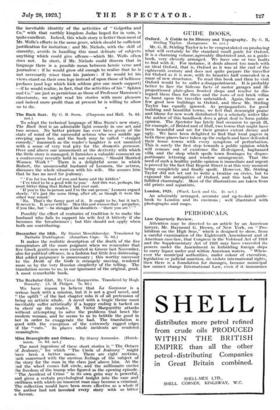GUIDE BOOKS.
Oxford. A Guide to its History and Topography. By G. It. Stirling Taylor. (Longmans. 48. net.) Mr. G. R. Stirling Taylor is to be congratulated on producing what will certainly be the standard small guide for Oxford. It is a charming volume, agreeably illustrated and, as a guide- book, very cleverly arranged. We have one or two faults to find with it. For instance, it deals almost too much with an ideal Oxford, that is, Oxford as it was at the end of the eighteenth century and does not quite prepare the traveller for Oxford as it is now, with its beauties half concealed in a maze of new structures. To read this book and then to visit Oxford would be to suffer a disappointment. It is probably better to face the hideous facts of motor garages and ill- proportioned plate-glass fronted shops and resolve to dis- regard them than for these and the rows of red brick villas to burst upon the traveller unheralded. Again, there are a few good new buildings in Oxford, and these Mr. Stirling Taylor has equally ignored. As propagandists for good building and beautiful towns, we feel that downright praise and blame for new work distributed by a scholarly writer like the author of this handbook does a great deal to form public opinion. The Spectator has lately had occasion to speak ill, for example, of Bristol and of Hull, two towns that might have been beautiful and are for their greater extent dreary and ugly. We have been delighted to find that local papers in both these places have taken up the cudgels and have defended their home towns with every symptom of perturbation. This is surely the first step towards a public opinion which will censure out of existence the ill-designed, haphazard villa and the shop which spoils town frontages by dispro- portionate lettering and window arrangement. That the need of such a healthy public opinion is immediate and urgent is proved by the fact that Regent Street is at this very moment being completely and finally spoilt. However, Mr. Stirling Taylor did not set out to write a treatise on civics, but to expound the antiquities of Oxford, and this task he has fulfilled charmingly. Most of the illustrations are taken from old prints and aquatints.






































 Previous page
Previous page